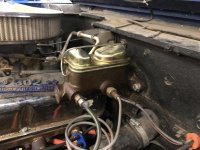did your old '71 also have 33x12.50's? Or were they tires smaller by any chance? Can make a big difference.
Also, do you know what size the piston is in your master cylinder? If it's not 1" or less, then you're fighting the fact that it's still manual brakes. A 7/8" or 15/16" or at the most 1" bore is all you want with manual brakes.
Anything else changed?
In answer to your question about the prop valve, first of all it is not a prop valve. Or at least the original wasn't. Those were simple "H-blocks" who's only function was as a way to hold the brake differential valve to turn on the dash warning light should there be a leak in one circuit (uneven pressure between front and back).
And even if you have installed a proper proportioning valve (called a combination valve for all the things it handles) it will not improve your braking to change type. Their job(s) are not to improve braking power. Only braking stability for lack of a simpler term.
However, if yours is actually defective, or blocked somehow, yes it can negatively impact brake power. If it's plugged, or the delay/metering valve is stuck for example, the front brakes might not be getting the full pressure.
For that you either need to test with a gauge or just replace it and hope that fixes it.
But before you spend money you should verify that it is in fact the problem. Very frustrating to throw a new part on it only to find out it was not the issue.
First pic is of a standard '68 to '75 pressure differential valve (H-block).
Second pic looks like a standard master cylinder, but so many look the same you'll have to measure your piston to see what size was used. Did you do the install those years ago, or buy it this way?
Third looks like the standard GM swap to your basic early seventies GM caliper and bracket setup. Easy bolt-on for pre-disc brake Fords.
Don't know exactly what the rears are, but back then there were a lot of Cadillac calipers being used. Yours do not have a parking brake setup? Or do they?
Have you ever driven it with this setup? If not, there are a lot more things you need to go through before you can settle on the actual culprit. Tubes, hoses, masters, pedal ratios (not usually messed with, but it might have been so you need to verify), clogged H-block, all sorts of stuff.
If you look over the top of your front tire, or if no tire just down from above the front calipers, do you see plenty of daylight between the calipers and knuckles? When doing this type of conversion you have to grind a fair amount of the original steering knuckle down for caliper clearance. As the pads wear that gap gets smaller, so if it was too small to begin with, a few thousand miles of use can sometimes get into a clearance issue.
And speaking of age and disc brakes... Which we weren't of course, but this can make a difference as well. The disc pads can become glazed and not grip near as well as they should. Not only that, but the particular pad material makes a HUGE difference. Some pads just don't grip well. Or they don't grip until heated up.
So you see, lots still to check. Even wheel bearings need to be checked, readjusted or replaced. The rears are almost done at 100k miles usually, so are on borrowed time thereafter. Especially the small-bearing model.
Front bearings can last the life of the vehicle, but only if properly maintained for it's entire life. Which rarely happens anymore...
Good luck. Let us know each time you check something and what you find, so we can either rule it out, or see if you need to dig into that bit more.
But don't overlook rust and clogging in the system. It looks a bit rough on the outside, and that can sometimes indicate what it's looking like on the inside. Here again, especially if not maintained regularly including changing the fluid every few years (which most never do!).
Paul














